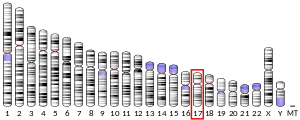NPTX1
Neuronal pentraxin-1 (NP1) is a protein that in humans is encoded by the NPTX1 gene.[5][6]
| NPTX1 | |||||||||||||||||||||||||
|---|---|---|---|---|---|---|---|---|---|---|---|---|---|---|---|---|---|---|---|---|---|---|---|---|---|
| Identifiers | |||||||||||||||||||||||||
| Aliases | NPTX1, NP1, neuronal pentraxin 1 | ||||||||||||||||||||||||
| External IDs | OMIM: 602367 MGI: 107811 HomoloGene: 1891 GeneCards: NPTX1 | ||||||||||||||||||||||||
| |||||||||||||||||||||||||
| |||||||||||||||||||||||||
| |||||||||||||||||||||||||
| Orthologs | |||||||||||||||||||||||||
| Species | Human | Mouse | |||||||||||||||||||||||
| Entrez | |||||||||||||||||||||||||
| Ensembl | |||||||||||||||||||||||||
| UniProt | |||||||||||||||||||||||||
| RefSeq (mRNA) | |||||||||||||||||||||||||
| RefSeq (protein) | |||||||||||||||||||||||||
| Location (UCSC) | Chr 17: 80.47 – 80.48 Mb | Chr 11: 119.54 – 119.55 Mb | |||||||||||||||||||||||
| PubMed search | [3] | [4] | |||||||||||||||||||||||
| Wikidata | |||||||||||||||||||||||||
| |||||||||||||||||||||||||
Function
NPTX1 is a member of the neuronal pentraxin gene family. Neuronal pentraxin 1 is similar to the rat NP1 gene which encodes a binding protein for the snake venom toxin taipoxin. Human NPTX1 mRNA is exclusively localized to the nervous system.[6]
References
- GRCh38: Ensembl release 89: ENSG00000171246 - Ensembl, May 2017
- GRCm38: Ensembl release 89: ENSMUSG00000025582 - Ensembl, May 2017
- "Human PubMed Reference:". National Center for Biotechnology Information, U.S. National Library of Medicine.
- "Mouse PubMed Reference:". National Center for Biotechnology Information, U.S. National Library of Medicine.
- Omeis IA, Hsu YC, Perin MS (September 1996). "Mouse and human neuronal pentraxin 1 (NPTX1): conservation, genomic structure, and chromosomal localization". Genomics. 36 (3): 543–5. doi:10.1006/geno.1996.0503. PMID 8884281.
- "Entrez Gene: neuronal pentraxin I".
Further reading
- Kirkpatrick LL, Matzuk MM, Dodds DC, Perin MS (2000). "Biochemical interactions of the neuronal pentraxins. Neuronal pentraxin (NP) receptor binds to taipoxin and taipoxin-associated calcium-binding protein 49 via NP1 and NP2". J. Biol. Chem. 275 (23): 17786–92. doi:10.1074/jbc.M002254200. PMID 10748068.
- Gerhard DS, Wagner L, Feingold EA, et al. (2004). "The status, quality, and expansion of the NIH full-length cDNA project: the Mammalian Gene Collection (MGC)". Genome Res. 14 (10B): 2121–7. doi:10.1101/gr.2596504. PMC 528928. PMID 15489334.
- Abad MA, Enguita M, DeGregorio-Rocasolano N, et al. (2006). "Neuronal pentraxin 1 contributes to the neuronal damage evoked by amyloid-beta and is overexpressed in dystrophic neurites in Alzheimer's brain". J. Neurosci. 26 (49): 12735–47. doi:10.1523/JNEUROSCI.0575-06.2006. PMC 6674827. PMID 17151277.
- Takahashi T, Strittmatter SM (2001). "Plexina1 autoinhibition by the plexin sema domain". Neuron. 29 (2): 429–39. doi:10.1016/S0896-6273(01)00216-1. PMID 11239433.
- Ota T, Suzuki Y, Nishikawa T, et al. (2004). "Complete sequencing and characterization of 21,243 full-length human cDNAs". Nat. Genet. 36 (1): 40–5. doi:10.1038/ng1285. PMID 14702039.
- Poulsen TT, Pedersen N, Perin MS, et al. (2005). "Specific sensitivity of small cell lung cancer cell lines to the snake venom toxin taipoxin". Lung Cancer. 50 (3): 329–37. doi:10.1016/j.lungcan.2005.06.011. PMID 16115696.
- Kimura K, Wakamatsu A, Suzuki Y, et al. (2006). "Diversification of transcriptional modulation: large-scale identification and characterization of putative alternative promoters of human genes". Genome Res. 16 (1): 55–65. doi:10.1101/gr.4039406. PMC 1356129. PMID 16344560.
- Strausberg RL, Feingold EA, Grouse LH, et al. (2002). "Generation and initial analysis of more than 15,000 full-length human and mouse cDNA sequences". Proc. Natl. Acad. Sci. U.S.A. 99 (26): 16899–903. doi:10.1073/pnas.242603899. PMC 139241. PMID 12477932.
This article incorporates text from the United States National Library of Medicine, which is in the public domain.
This article is issued from Wikipedia. The text is licensed under Creative Commons - Attribution - Sharealike. Additional terms may apply for the media files.



